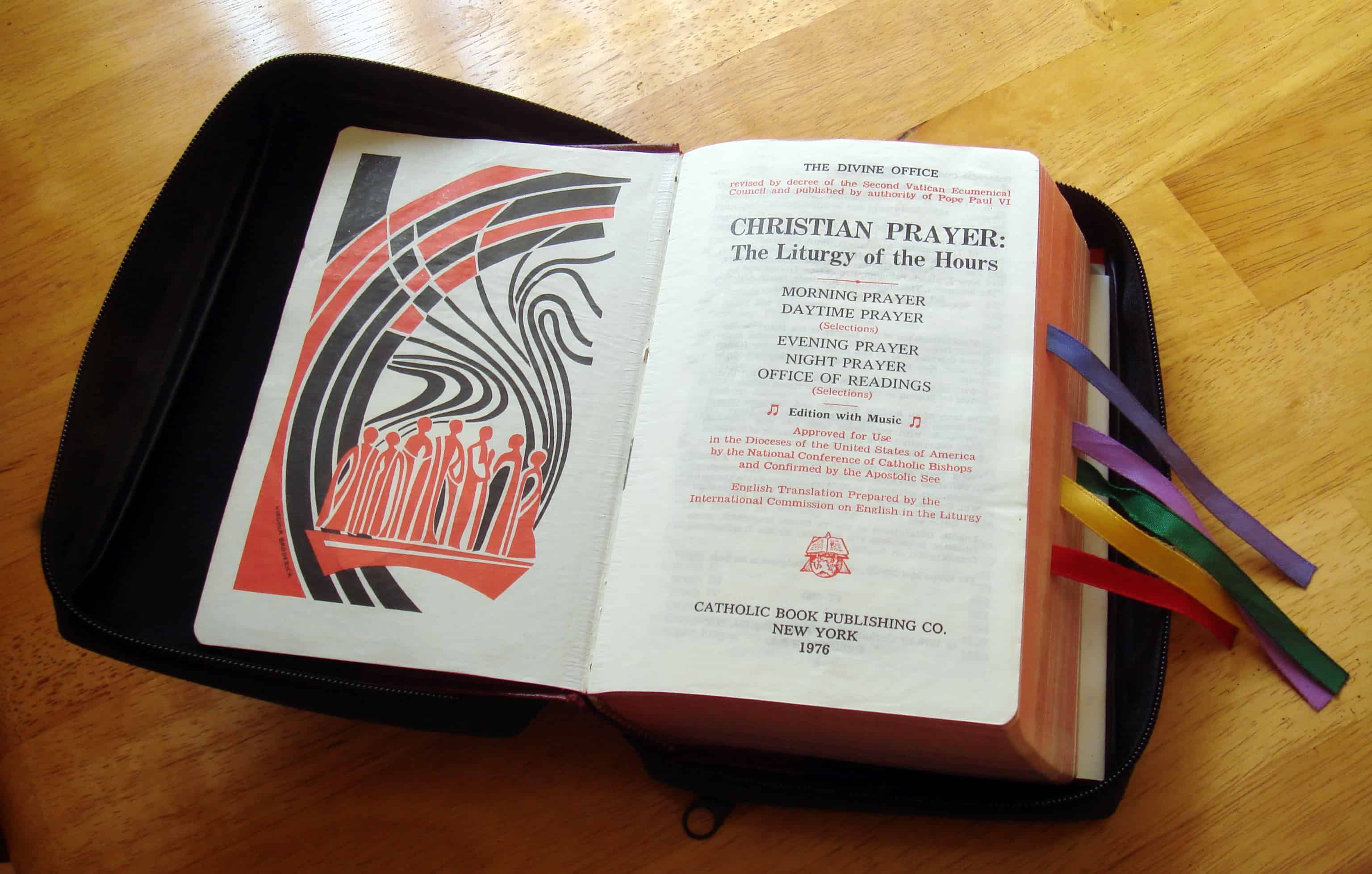God, come to my assistance.
Lord, make haste to help me.
One of the first things I was given as a Jesuit novice was the book Christian Prayer: The Liturgy of the Hours, a one volume version of the Liturgy of the Hours. A couple of things crossed my mind at that moment: “What the heck is the Liturgy of the Hours?” and “How am I going to figure out how to pray this in the next five minutes?” There were all these ribbons in the book, and I watched as the second year novices skillfully moved between different parts of the book without batting an eye or missing a line. How was I going to figure this all out?
I’m happy to report that over the past few years, this prayer has become a regular part of my prayer life. I’ve prayed it alone (most of the time). I’ve also prayed it in community with others, sometimes speaking and sometimes chanting. Let’s be honest, the chanting has been a little rough.
There is a misperception that the Liturgy of the Hours is just for ordained or vowed religious, but here’s the thing: it is open to all to pray. “The Liturgy of the Hours, the [Second Vatican] Council tells us, is our association with Christ in singing that eternal hymn of praise.”1 All of us are invited to pray the Liturgy of the Hours with each other, whether that happens to be alone in our rooms, with a small group before a daily mass, or with a larger monastic community.
One of the first questions I had when I started praying it was: “why is it called a Liturgy?” We call it a liturgy because it is a public prayer of the Church (like Mass or the other Sacraments), which includes hymns, psalms, readings, and prayers according to the liturgical calendar. The Church distinguishes liturgy, which is public prayer, from private devotions, like praying the rosary.
The Liturgy of the Hours has a long history in the Catholic Church. But surprisingly, recalling my own arrival at the novitiate, it isn’t very well known. I was talking with a good friend, and fellow theology student, about what her first reaction was when she heard about the Liturgy of the Hours. She came back with three responses from her and a couple of other theology students: “Never heard of it,” “It’s beautiful, but I’m tired,” and “Not interested.” So I figure these three responses are a good way to frame this brief introduction to this prayer.
“Never Heard of It.”
That makes a lot of sense! Most Catholics may be vaguely aware that it exists, but have never had the opportunity to pray with it. Very briefly, the Liturgy of the Hours is based in the psalms. There are five “hours” during the day: Morning, Daytime, Evening, Night, and Office of Readings. They do not actually take an hour to pray, each one can be about 15-20 minutes.
Night prayer is my favorite one, although it can be a little dark at times. For example, Friday night prayer is from Psalm 88 featuring the line, “Darkness is my only companion.” But the sun has set by the time I’m praying it, so there’s something fitting about those words.
The Liturgy of the Hours also consists of a four-week cycle, and it has different prayers available for certain feast days. Timothy Gallagher puts it very nicely saying, “It is first and above all a prayer of praise; then, immediately after that, a prayer of intercession for the salvation of the whole world, for the needs of all the members of the Church and all the people in the world.”
Anyone can pray this. If it sounds a little complicated, that’s okay. There is a great app, iBreviary, which offers a user-friendly approach to praying it. Basically, you pick the hour of the day you want to pray, and just scroll your way through the psalms, antiphons, and prayers in order. No ribbons!
“It’s beautiful, but I’m tired.”
True! This prayer of praise is rooted in the psalms, and if you pray all five hours for four weeks, you go through almost all 150 psalms. The psalms are beautiful because they reflect the variety moods of our life: happiness, anger, sadness, praise, gratitude…you get the point.
For most of the hours we begin with this line, “God, come to my assistance. Lord, make haste to help me.” I find this line incredibly beautiful because it often sums up how I am feeling, and it recognizes at the beginning of prayer that I need God and I can’t do this on my own.
As for feeling tired, I’m with you, but this is the great thing about this prayer. There are five times you can pray with it throughout the day, and you don’t have to do all five. Maybe all you have is 10-15 minutes at lunchtime. Well, that sounds like a great time to pray afternoon prayer. And if you fall asleep while praying, that sounds like a great invitation to rest with God.
“Not Interested.”
Fair enough! This is just one way of praying, like the rosary, the Examen, Ignatian contemplation, or lectio divina. They are all great ways of praying. This is one more tool for growing closer to God. Sometimes in our lives one form of prayer may be better for us than others. The invitation to pray the Liturgy of the Hours is always available, and it can be a source of nourishment in our lives.
If you’re interested in trying out this prayer, I recommend starting with the iBreviary app and choosing a time of day that might work well. If you want to go beyond the app and use the book with all the ribbons, I recommend asking for someone’s help as you pray through it. You will learn quicker by actually practicing it than reading instructions. And you will be surprised at how quickly you can pick it up, too.
Try it out for a week, and see how it goes. Even if you are praying it by yourself, you aren’t praying alone. You are praying with those around the world who might be on their own too, those gathered together, and the entire communion of saints.
Joan Chittister, O.S.B. has centered her life on this prayer as a Benedictine. She says this about prayer: “We go to prayer to be transfigured ourselves, to come to see the world as God sees the world, to practice the presence of God, to put on a heart of justice, of love, and of compassion for others.” Praying daily with the word of God, either in daily scripture or through the Liturgy of the Hours, helps us, little by little, to see the world, our neighbors, and even ourselves as God sees us.
- Timothy Gallagher, “A Layman’s Guide to the Liturgy of the Hours.” ↩


